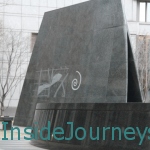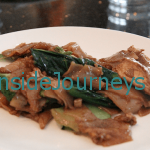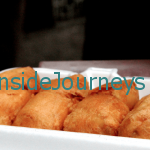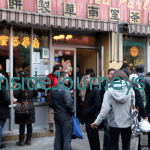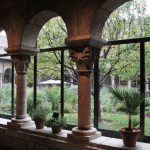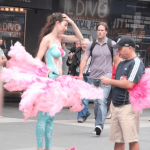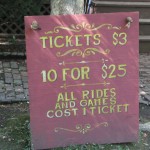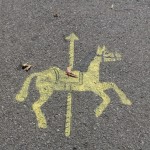Several times a month, especially in the summer, I see ‘No Parking’ signs like these taped to utility poles in my neighborhood. I always stop and read them.

Which movie or television show will they be filming?
According to the Mayor’s Office of Media and Entertainment’s website, New York City had a supporting role in 46 television series and 256 movies during the 2014-2015 season. The industry contributed $8.7 billion to the local economy.
With this much filmed entertainment, it’s not surprising to spot a star or two. But the city, with its many iconic locations, is without doubt, the real attraction.
Late last year, I took the When Harry Met Seinfeld Tour, which On Location Tour organizes. Starting from 55th Street near 8th Avenue, the bus tour winds it way around the Columbus Circle area into Upper Manhattan revealing 30 spots that were featured in classic and contemporary movies or television shows.
Tour guides are local actors and actresses who know all about the City’s rich movie history and share them eagerly.
As the tour got underway, our guide (sorry, I neglected to note his name) asked us to share where we were from. There were people from Toronto, Tokyo, Australia, Brazil, the Midwest, California and other parts of the US but I was the only person from New York.
The first location our guide pointed out was the Soup Man. You might remember it from Seinfeld. About the size of a New York deli, I had passed it without even noticing.

Towards Columbus Circle, our guide drew our attention to the statue of Christopher Columbus, which can be seen in several movies, including Ghostbusters.

Leaving Columbus Circle, we headed to the Upper West Side and Lincoln Center’s famous fountain. It’s really an impressive sight, especially at night. We didn’t stop but if you get a chance, go see it or look for it in Moonstruck, Glee, Sweet Home Alabama and Pitch Perfect.
At 69th Street and Columbus Avenue, we found the location, now an organic cleaners, of Meg Ryan’s bookstore in You’ve Got Mail.
We stopped for photos of Tom’s Restaurant at Broadway and 112th Street. Seinfeld fans will recognize it as Monks.

Still on the Upper West Side, we cruised pass Café Luxemborg, which you might remember from When Harry Met Sally, then stopped at long enough at Café Lalo for those who wanted to could get coffee. Café Lalo is where Tom Hanks attempted to meet Meg Ryan for their date in You’ve Got Mail.

If you’ve seen Manhattan, with Diane Keaton and Woody Allen, you might have seen Zabar’s on 80th & Broadway. Carmine’s on 91st was in Keeping the Faith with Ed Norton and Ben Stiller.
Central Park has played supporting roles in movies like Home Alone II, Breakfast at Tiffany’s, Smurfs, Friends with Benefits, Angels in America, Elf, Kramer vs Kramer, and The Avengers.
On the Upper East Side’s Museum Mile, you’ll find the Museum of the City of New York where the star of television’s Gossip Girl goes to school; the Guggenheim Museum where Isaac and Mary meet in Manhattan; also Men in Black, When in Rome, and other movies.

Further down Fifth Avenue is the Metropolitan Museum of Art, our last stop. Who doesn’t want to sit on the graceful Met Steps, like the Gossip Girl did? The Met was also the setting for I Am Legend, When Harry Met Sally, Hitch and Maid in Manhattan.
The Carnegie Mansion was the backdrop for films like Arthur, Working Girl and Marathon Man.
We passed by these other Upper East Side locations before returning to 55th & 8th Avenue: the Lutheran Church featured in the Devil’s Advocate, the New York Armory in Boardwalk Empire (television show), the Met Life Building in Superman, Barney’s in Will and Grace, the Pierre Hotel in Scent of a Woman and the St. Regis Hotel from Miss Congeniality.
Current shows that are filmed in New York: the Blacklist, Blue Bloods, Elementary, Good Wife, Law & Order SVU, Limitless, Madam Secretary, Mysteries of Laura. Morning and late night shows such as Saturday Night Live, the Today Show, The Late Show with Stephen Colbert, The Tonight Show Starring Jimmy Fallon, Late Night with Seth Meyers, Good Morning America, Live with Kelly & Michael, The View, The Chew, the Rachel Ray Show.
Also filmed in New York: Bridge of Spies, On the Town, On the Waterfront and West Side Story.
When Harry Met Seinfeld Tour Particulars
Duration: Approximately 2 hours
Cost: $37 (adults), $21 (children)
You meet the tour bus at McGhee’s on 55th between Broadway and 8th Avenue
The When Harry Met Seinfeld Tour was complimentary; this recap my own.
Linking this week with Travel Photo Thursday which Nancie at Budget Travelers Sandbox, Ruth at Tanama Tales, Jan at Budget Travel Talk and Rachel at Rachel’s Ruminations.
9Also linking to Weekend Travel Inspiration hosted by Albom Adventures, Reflections Enroute, TheCrowdedPlanet, ContentedTraveller, Safari254, Families Go! and Malaysian Meanders.





